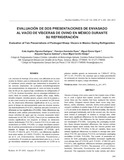Evaluación de dos presentaciones de envasado al vacío de vísceras de ovino en méxico durante su refrigeración

Voir/
Date
2013-06-18Auteur
Palabras Clave
Ovis aries, barbacoa, aw, pH, UFCOvis aries, “barbacoa”, Aw, pH, CFU
Metadatos
Afficher la notice complèteRésumé
Las vísceras de borrego (Ovis aries) son utilizadas en la zona
central de México para la elaboración del platillo típico “pancita”
existiendo pocos estudios que determinen la inocuidad de
las vísceras empleadas. Se evaluaron microbiológicamente
dos presentaciones de empacado al vacío en bolsa de polietileno
de 60 μm de espesor bajo condiciones de refrigeración (7
± 2°C) de vísceras troceadas: una en empaque individual (corazón,
falda de corazón, pulmón, hígado, riñón, cuajo, librillo,
intestino delgado, intestino grueso, panza y tela de la panza) y,
la otra como mezcla de vísceras, por un periodo de 228 horas
(h). Se observaron diferencias significativas de la aw con respecto
al tiempo de almacenamiento para las vísceras envasadas
individualmente (P<0,001), mientras que para la mezcla, la
diferencia no fue significativa (P=0,088). Hubo diferencias significativas
entre ambas presentaciones, donde la mezcla tuvo
mayor actividad de agua que las vísceras envasadas individualmente
(U=42,798, P=0,002). Para el pH no existieron diferencias
significativas con respecto al tiempo de almacenamiento
(individuales P=0,750 y mezcla P=0,314) ni entre presentaciones
(U=3094, P=0,059). La carga microbiana anaerobia
de ambas presentaciones se incrementó significativamente
durante el tiempo de almacenamiento (X2=318,92, gl=5,
P<0,001; X2=68,516, gl=5, P<0,001), con diferencias significativas
entre ambas (U=1028,5, P<0,001). Se detectó la presencia
de E. coli, Enterobacterias, Salmonella, Pseudomonas y
Lactobacillus. El modelo de regresión lineal para la aw y la carga
microbiana estableció que, un incremento en 0,039 en la
primera variable generó un incremento en 7,895x107 UFC/g
(R2= 0,141, P<0,001). Se concluye que la mejor presentación
de envasado de vísceras fue de manera individual al tener menor
actividad de agua y carga microbiana.
Colecciones
Información Adicional
| Otros Títulos | Evaluation of Two Presentations of Packaged Sheep Viscera in Mexico During Refrigeration |
| Correo Electrónico | fhrosas@colpos.mx |
| ISSN | 0798-2259 |
| Resumen en otro Idioma | Viscera of sheep (Ovis aries) used in the Central zone of Mexico to cook a typical dish named “pancita”, despite its relevance there are few studies that have analyzed the viscera food safety. Chopped viscera (heart, heart cover, lung, liver, kidney, curdle, intestines, stomach, librillo) were packed under vacuum conditions in plastic bags of 60 µm and refrigerated (7 ± 2°C) in order to be observed. In the first modality, the viscera were packaged individually and in the second one, the viscera were mixted of packaged. In relation to storage time, while there were significant differences for the individually packaged viscera (P<0.001), the difference for the viscera mixture was not meaningful (P=0.088). Comparing the packaging modalities, these showed important differences, the viscera mixture observed higher water activity than the viscera packed individually (U=42.798, P=0.002). In the pH variable, there were neither significant differences in relation to storage time (individual P=0.750 and mixture P=0.314) nor between packaging modalities (U=3094, P=0.059). The counts of anaerobia microbes for both packaging modalities increased significantly over storage time (X2=318.92, gl=5, P<0.001; X2=68.516, gl=5, P<0.001), with significant differences between packaging modalities (U=1028.5, P<0.001). The presence of E. coli, Enterobacterias, Salmonella, Pseudomonas and Lactobacillus was observed. The regression model for water activity and microbial counts revealed that an increase of 0.039 in the first variable produced a 7.895x107 increase in the second one (R2= 0.141, P<0.001). It can be concluded that the best way to package viscera is individually. Still, it is recommended to improve the hygienic practices during the slaughter and to reduce the storage temperature. |
| Periodicidad | Bimestral |
| País | Venezuela |
| Institución | Universidad del Zulia (LUZ) Universidad de Los Andes (ULA) |
| Publicación Electrónica | Revista Científica |
| Sección | Revista Científica: Tecnología de Alimentos |





